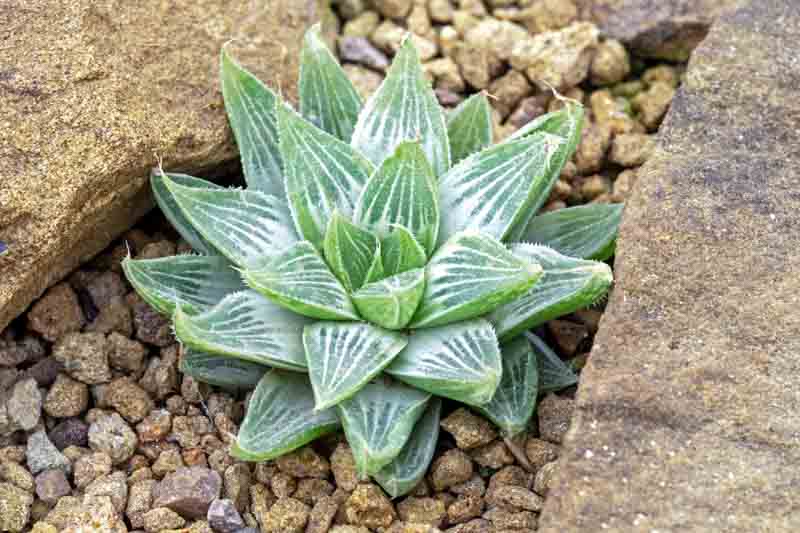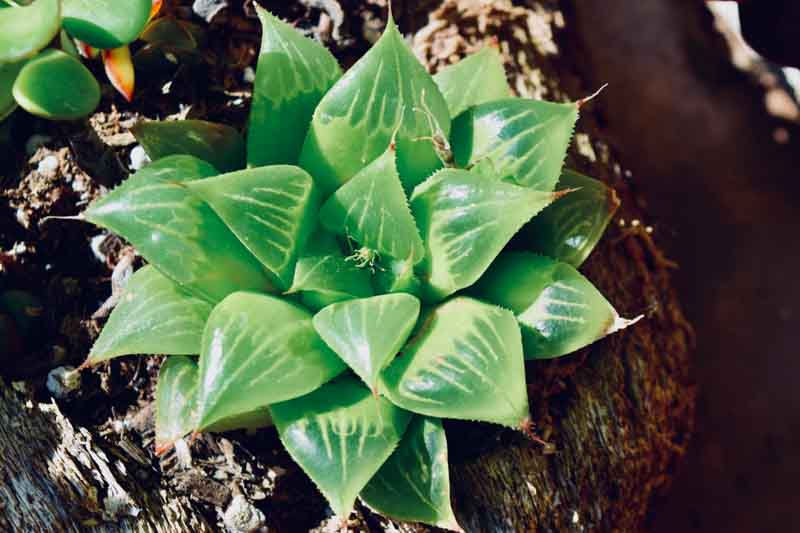Aloe retusa, Cushion Aloe, Star Cactus
Haworthia retusa, a fascinating and robust succulent, is esteemed among gardeners and plant enthusiasts for its unique appearance and ease of care. This compact plant is a testament to nature’s artistry, showcasing a blend of resilience and beauty that captivates and delights.
Haworthia retusa is characterized by its striking, star-shaped rosettes of thick, fleshy, triangular leaves. The leaves are notable for their glossy, transparent tips, which resemble the facet of a gemstone. These tips allow light into the interior of the leaf for photosynthesis, giving the plant a luminous, almost crystalline appearance, especially when backlit by sunlight.
Native: This plant is native to the Western Cape Province of South Africa, where it thrives in semi-arid environments. In its natural habitat, Haworthia retusa often grows in the shade of rocks or other vegetation, shielding it from the intense African sun. Haworthia retusa belongs to the Asphodelaceae family along with Aloe, Eremurus (Foxtail Lily), and Hemerocallis (Daylily).
Plant Type and Habit: Haworthia retusa is a perennial succulent that forms compact rosettes that grow singularly or in small clusters. The plant’s growth habit is low and slow, making it ideal for small spaces and containers.
Size: The plant remains relatively small, typically reaching heights of about 3 to 6 inches (8-15 cm) and spreading to approximately 4 to 6 inches (10-15 cm) in width. Its modest size makes it a perfect fit for indoor cultivation.
Flowers: Haworthia retusa produces slender, stem-like inflorescences, up to 20 inches tall (50 cm), that bear small, tubular, white or pale pink flowers. The flowers are delicate and appear primarily in the winter.
Foliage: The foliage is the most distinctive feature, with very thick, triangular, translucent, lime green leaves that taper to a point. The leaves are arranged in a rosette pattern, creating a striking visual effect.
Hardiness: It is hardy in USDA zones 10 to 11. While it can tolerate brief cold periods down to about 30°F (-1°C), it is not frost-tolerant and should be protected from extreme cold temperatures.
Award: Recipient of the prestigious Award of Garden Merit of the Royal Horticultural Society.
Uses: Haworthia retusa is primarily used as an ornamental plant, suitable for indoor gardens, terrariums, and as a desk plant. Its low water requirements and compact size make it an excellent choice for xeriscaping and sustainable landscaping in suitable climates.
Toxicity: Haworthia retusa is generally considered non-toxic to pets and humans, making it a safe choice for households with animals.
Drought: Like most succulents, Haworthia retusa is highly drought-tolerant once established, requiring minimal watering.
Invasiveness: This plant is not invasive and is well-contained within its growing area, making it a responsible choice for gardens and indoor settings.
Benefits: Its water-wise nature aligns with eco-friendly gardening practices, and its ease of care makes it a fantastic plant for beginners.

Growing and caring for Haworthia retusa is a rewarding experience due to its undemanding nature and attractive appearance. This succulent is well-suited for beginners and those looking for low-maintenance plants.
Light: Haworthia retusa thrives in bright, indirect light. It can tolerate some direct sunlight, especially in the morning or late afternoon, but prolonged exposure to harsh midday sun can cause leaf scorch. If grown indoors, a spot near a south-facing window covered with a sheer curtain is ideal.
Soil: Use a well-draining succulent or cactus mix to ensure excess water drains away quickly. You can enhance drainage by adding perlite or sand to regular potting soil. Good drainage is critical to prevent root rot.
Water: Water sparingly. The key is to let the soil completely dry out between watering sessions. Overwatering is the most common cause of problems with Haworthia retusa, leading to root rot. Reduce watering frequency during the winter months when the plant’s growth slows down.
Temperature: This succulent prefers average indoor temperatures, ranging from about 60°F to 80°F (15°C to 27°C). It can tolerate brief drops in temperature but should be protected from frost, which can be damaging.
Humidity: Haworthia retusa does not have specific humidity requirements, making it well-suited to most homes.
Feeding: Fertilize lightly during the growing season (spring and summer) using a diluted (half-strength) liquid succulent fertilizer. Do not overfertilize, as this can harm the plant. Avoid fertilizing in fall and winter when the plant is not actively growing.
Potting and Repotting: Choose a container with drainage holes at the bottom to allow excess water to escape. Although Haworthia retusa does not have a large root system, repotting every few years in spring can refresh the soil and provide room for growth. This is also a good time to remove and pot up any offsets.

Propagating Haworthia retusa is a straightforward and rewarding process, primarily done through offsets, also known as pups. These are small, new plants that form around the base of the mother plant, emerging from its root system. Here’s how to propagate Haworthia retusa using offsets:
Identify and Separate Offsets: Wait until the offsets have grown to a reasonable size (at least one-third the size of the parent plant) and have developed their own roots. This makes them more likely to survive when separated.
Remove Offsets: Carefully remove the soil around the base of the mother plant to expose the offsets. Using a clean, sharp knife or scissors, cut the offset from the mother plant, ensuring that you include some roots with the offset. If the offset is easily detachable without cutting, you can gently twist it off by hand.
Let Offsets Dry: After separating the offsets, allow them to dry for a day or two. This helps the cut area callous over, reducing the risk of rot when planted.
Plant Offsets: Fill a small pot with a well-draining succulent or cactus mix. Plant the offset in the soil, burying it just deep enough to stand upright. While the offset is establishing roots, ensure the soil is slightly moist but never waterlogged.
Water Carefully: Initially, water the newly potted offset lightly to encourage root growth. Wait until the top layer of soil dries out before watering again. Overwatering can be detrimental to the young plants, especially before they have established a robust root system.
Provide Suitable Conditions: Place the pot in a location where it receives bright, indirect light. Avoid direct sunlight to prevent sunburn. A stable environment with temperatures ranging from 60°F to 80°F (15°C to 27°C) is ideal.
Growth and Repotting: Over time, as the offset grows and establishes, you can gradually introduce it to the same care regimen as the mature plants. Repotting is typically necessary every few years or when the plant outgrows its pot.
Haworthia retusa is generally easy to care for, but like all plants, it can encounter pests, diseases, and common problems.
Mealybugs: These tiny, white, cottony pests tend to hide in the crevices of the plant, sucking sap and weakening it. Treat by dabbing the pests with a cotton swab dipped in rubbing alcohol or applying neem oil.
Spider mites: Indicated by fine webbing on the plant, these pests thrive in dry conditions. Increase humidity around the plant and rinse it off with water. Neem oil can also be effective.
Aphids: Small and typically found on new growth. They can be washed off with a strong jet of water or treated with neem oil.
Fungus gnats: Overwatering can lead to fungus gnat problems, as these pests are attracted to moist soil. Reducing watering and allowing the soil to dry out can help prevent them.
Root rot: This is the most common problem, usually resulting from overwatering. Symptoms include soft, brown roots and a base that feels mushy. Prevention is key; ensure the soil is well-draining and allow it to dry out completely between waterings. Affected plants should be repotted after removing the rotted roots.
Fungal Infections: Overly humid conditions or wet leaves can lead to fungal diseases like powdery mildew. Ensure good air circulation around the plant and avoid wetting the leaves when watering. Fungicides can be used in severe cases.
Etiolation (Stretching): If Haworthia retusa doesn’t receive enough light, it may start to stretch out, losing its compact shape. To prevent this, ensure it gets plenty of bright, indirect sunlight.
Leaf Burn: Direct, intense sunlight can cause the leaves to burn, leading to brown or scorched spots. If you notice signs of sunburn, move your plant to a location with more shade or filtered light.
Water Stress: Overwatering can lead to mushy, translucent leaves, while underwatering results in wrinkled, shriveled leaves. Finding the right balance is crucial—water only when the soil is completely dry.
| Hardiness |
10 - 11 |
|---|---|
| Heat Zones |
10 - 12 |
| Climate Zones | 15, 16, 17, 20, 21, 22, 23, 24 |
| Plant Type | Houseplants, Cactus & Succulents |
| Plant Family | Asphodelaceae |
| Genus | Haworthia |
| Exposure | Full Sun, Partial Sun |
| Season of Interest |
Spring (Early, Mid, Late) Summer (Early, Mid, Late) Fall Winter |
| Height |
3" - 6" (8cm - 15cm) |
| Spread |
4" - 6" (10cm - 15cm) |
| Spacing |
4" - 6" (10cm - 15cm) |
| Maintenance | Low |
| Water Needs | Low |
| Soil Type | Loam, Sand |
| Soil pH | Alkaline, Neutral |
| Soil Drainage | Well-Drained |
| Characteristics | Showy, Evergreen, Plant of Merit |
| Tolerance | Drought |
| Garden Uses | Patio And Containers |
| Hardiness |
10 - 11 |
|---|---|
| Heat Zones |
10 - 12 |
| Climate Zones | 15, 16, 17, 20, 21, 22, 23, 24 |
| Plant Type | Houseplants, Cactus & Succulents |
| Plant Family | Asphodelaceae |
| Genus | Haworthia |
| Exposure | Full Sun, Partial Sun |
| Season of Interest |
Spring (Early, Mid, Late) Summer (Early, Mid, Late) Fall Winter |
| Height |
3" - 6" (8cm - 15cm) |
| Spread |
4" - 6" (10cm - 15cm) |
| Spacing |
4" - 6" (10cm - 15cm) |
| Maintenance | Low |
| Water Needs | Low |
| Soil Type | Loam, Sand |
| Soil pH | Alkaline, Neutral |
| Soil Drainage | Well-Drained |
| Characteristics | Showy, Evergreen, Plant of Merit |
| Tolerance | Drought |
| Garden Uses | Patio And Containers |
How many Haworthia retusa (Star Cactus) do I need for my garden?
| Plant | Quantity | |
|---|---|---|
| Haworthia retusa (Star Cactus) | N/A | Buy Plants |
Create a membership account to save your garden designs and to view them on any device.
Becoming a contributing member of Gardenia is easy and can be done in just a few minutes. If you provide us with your name, email address and the payment of a modest $25 annual membership fee, you will become a full member, enabling you to design and save up to 25 of your garden design ideas.
Join now and start creating your dream garden!
Create a membership account to save your garden designs and to view them on any device.
Becoming a contributing member of Gardenia is easy and can be done in just a few minutes. If you provide us with your name, email address and the payment of a modest $25 annual membership fee, you will become a full member, enabling you to design and save up to 25 of your garden design ideas.
Join now and start creating your dream garden!